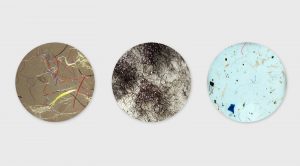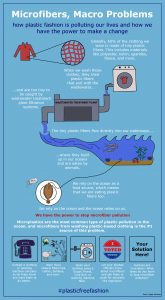
Microscopic views of microfibers.
Source: Bren School of Environmental Science and Management, UCSB
Microfibers are exactly what they sound like: super-tiny fibers. So tiny, they are microscopic. But this post has nothing to do with the fiber in your food. I know this is hard to believe if you’ve read my other blogs, but today I am not going to talk about your bowels. As a Community Educator at HRSD, I do that a lot. No, today I’m talking about the fibers that make up textiles like clothing and other things made out of fabric. So why does someone who works in sewage care about textiles and why the heck am I talking about shirts in a blog about plastic pollution?
Stick with me, because this is going to get good. Textiles can be made from natural fibers, like cotton, or synthetic fibers like polyester. Take a look at your clothing labels. Do any of them contain polyester, elastane, Lycra, or spandex? That’s plastic. We just love to have plastic in our clothes. About 60% of clothing sold worldwide is synthetic. Do you like your performance or outerwear to be “breathable” and light? I know I do, and that’s thanks to synthetic fibers. And let’s be honest ladies, most of us have a relationship with our yoga pants that doesn’t involve actual yoga. Sometimes you need just the right amount of stretch for your trip to the grocery store.

Microfibers are macro problems. SWIFT is one way we are addressing microfiber pollution in Hampton Roads. What ideas do you have to stop microfiber pollution?
Source: 5Gyres
Not only are you wearing plastic, you are wearing plastic that sheds. Just like my Lab mix manages to cover every dark surface in my house with a carpet of yellow hair, the clothes you wear shed fibers, and they shed a lot in the washing machine. A single synthetic garment sheds 1,900 plastic microfibers in the wash, an amount that weighs about 2 grams (more than a paperclip). Conventional wastewater treatment plants are not able to remove all of those tiny microscopic fibers, so when treated water is released into waterways, they sneak out like little ninjas. Natural microfibers break down quickly in the environment, but synthetic microfibers do not and contribute to microplastics pollution in our rivers and ocean. In fact, microplastics are thought to be the most common type of plastic pollution in our ocean, and laundered synthetic clothing is the #1 source of this problem, making up as much as 35% of the global total. Microplastics can release contaminants into water as well as attach to contaminants already in polluted water, which provide a pathway for some chemicals to march straight up the food chain.
It is easy to get overwhelmed with something so small creating such a big problem, but there are many ways individuals, businesses, and organizations around the world are working to solve this problem so that we can continue wicking moisture with abandon. Businesses like Patagonia and non-profit groups are researching how to minimize fiber shedding and our microfiber footprint. Here are a few of them you can do at home:
- Use your purchasing power. Buy textiles made from natural fibers like cotton, linen, hemp, bamboo, and many others.
- Wash less. Does your preschooler dress and redress herself 523,456,234 times in one day? Did you wear yoga pants to take a nap? My rule of thumb: If it passes the sniff test, wear not wash. You get double points for this one because you are also conserving water.
- Quality not quantity. High quality clothing sheds less.
- Use a top-load washer. Synthetic jackets shed five times more in front-load washers.
- Regardless of what type of washer you have, wash with a full load, liquid laundry detergent, cold water, low spin speed, and shorter cycle time. Basically, be gentle on your clothes.
- Try one of the new, innovative ways to filter those fibers yourself. I’ve got a microfiber-catching Cora Ball I throw in with my wash, but you could also try the Guppy Friend washing bag or install a washing machine filter.

My daughter, Cora, and the microfiber-catching Cora Ball. Plastic pollution doesn’t know what it’s up against with these two. How could I not get one?! Actually, my sister gave it to me. She gets me.
HRSD’s Sustainable Water Initiative for Tomorrow (SWIFT) should also reduce microplastics pollution here in Hampton Roads. SWIFT will take highly treated water that would otherwise be discharged into local rivers and put it through additional rounds of advanced water treatment to meet drinking water quality standards. This SWIFT Water will then be added to the Potomac Aquifer, the primary source of groundwater throughout eastern Virginia. This project is just getting started with the SWIFT Research Center opening in Suffolk this year. The plan is for multiple full-scale SWIFT facilities to be operating across Hampton Roads by 2030, which will put over 100 million gallons of water back into our shrinking aquifer. I know, I know, yay for not running out of groundwater, but what about plastic?!
Conventional wastewater treatment is already pretty impressive on its own. After all, it’s one of the main reasons the human lifespan has increased by more than 30 years over the past century or so. Clean water supports life, and since there are now over 7 billion people in the world and all of the water we have today is all we’ve ever had (yes, dinosaurs peed in your water), knowing how to clean water is really important. We’ve become a plastic planet and we’ve got to rethink a few things, from how products are made all the way down to how we dispose of them. That tail end is where HRSD‘s SWIFT comes in. SWIFT adds extra steps to the wastewater treatment process that are capable of filtering out extremely small particles, like microplastics, and HRSD is already working with scientists at VIMS to study microplastics removal at the SWIFT Research Center.
Now go dig out your athleisure wear and come visit HRSD and other askHRgreen.org members at the 2018 Virginia Beach Earth Day Celebration at Mount Trashmore this Saturday, April 21! There will be games, food, entertainment, and you’ll learn all about local environmental initiatives and eco-friendly products. Together, we can stop plastic pollution. And yes, I’ll be there talking about poop.